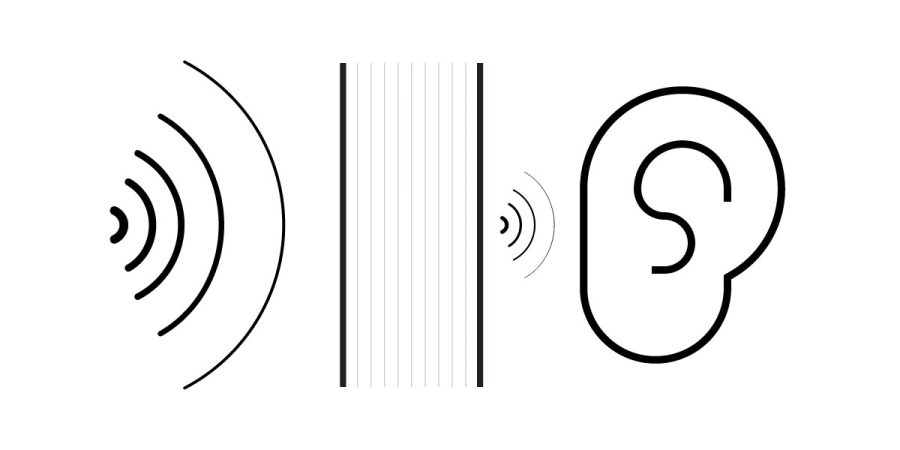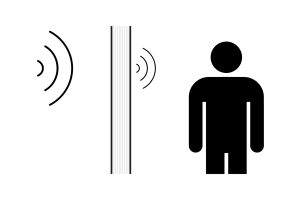Design Conditions
There are many building and program types which require sensitivity to sound. Some of these are obvious, like music venues and sound recording studios. Some are less obvious, but can severely alter a user’s experience, such as hospitality and multi-family; sound transmission from a hallway to units or between units.
Regardless, always look to the program’s specific needs to determine the conditions that need to be designed for. Special care should be noted for potentially extra or sensitive requirements if converting from one program use to another. A premium might need to be paid in order to make the space usable from a ‘sound’ perspective.
Sound Transmission vs Sound Absorption
Sound transmission is the amount of sound that makes it through a barrier; in other words, the amount of sound isolation. Sound absorption is the amount a material absorbs to stop reflecting the sound (reverberation) back into the space. If you have an echo in a room, you want to increase sound absorption. If you can hear your neighbors, you want to increase sound isolation.
Sound Transmission Class (STC)
Sound Transmission Class (STC): Average of a barrier’s ability to reduce sound over several frequency bands. Essentially, the higher the value, the better the barrier is at stopping sound, or in other words; the higher the value, the better the ability of the barrier to control sound transmission.
- STC Values are determined under ideal laboratory conditions. In reality, construction tolerances and quality of work should be taken into account, along with all the different types of openings in a barrier. For example, the STC rating of a wall does not matter much, if the construction of the wall does not exactly match those criterias; or the wall is perforated with many windows or openings.
- Walls and floors are generally rated with their STC Rating.
- Any openings in the barrier (doors, windows, MEP, etc) that have a lower STC rating than the barrier itself, will lower the overall rating of the barrier.
STC & IIC Chart
There are many different opinions on what constitutes a ‘good’ vs ‘very good’ rating, as the definitions are up for personal interpretation. Another factor to consider is the environment that you are basing these values against. An STC of 60 might be excellent in a hotel, but if located adjacent to an airport, it might not be just ‘very good’.
We’d recommend referencing an official testing agency for their charts, or requesting one from your acoustical consultant.
| STC & IIC | Relative Hearing | Performance |
| 20-29 | Speech is audible, even low speech. Normal speech is understood easily. | No Soundproofing / Very Poor |
| 30-39 | Normal/Loud speech heard and understood fairly well. | Fair / Good |
| 40-49 | Loud speech faintly heard, sometimes understandable. | Very Good / Great |
| 50-59 | Loud speech faintly heard, not understandable | Excellent |
| 60+ | Loud noises not heard or barely | “Soundproof” or nearly |
How to Control Sound Transmission
When needing to control sound in a barrier, and increase its STC; there are several guidelines to follow as best practices.
- All gaps in the barrier should be sealed. Sound travels around walls, so any openings or gaps are many times the weakest link.
- Edges between dissimilar materials, such as floor, ceiling, and intersection of walls should be caulked/sealed.
- Pipes, Ducts, and all HVAC should be sealed with caulk or other materials. The connection shouldn’t be rigid.
- Electrical outlets should not be located back to back in a wall and instead should be staggered.
Flanking Path: Sound paths that go around a barrier, like above a ceiling plenum or in/through an HVAC system. These paths should be eliminated as much as possible.

Door Sound Transmission
Doors are one of the biggest problem areas when dealing with sound, primarily due to its size and operation — it’s frequently considered the weakest link in soundproofing a room.
- Doors should be completely sealed around the perimeter. This includes the head, and both jambs; and should utilize a weather stripping or auto-closing sealer at the sill designed for sound sealing.
- Door should be as heavy as possible (solid core), or utilize sound proofing materials/construction in their core..
Automatic Door Closers
Automatic door closers are strips along the bottom of the door that retract when the door is in any amount of open %. When the door is completely closed, the strip has a plunge screw which gets depressed between the jamb and door, and extends the seal down to the bottom floor in order to create a secure closure.
This has a secondary benefit of not producing friction on the ground which can cause premature wear on a floor such as carpet.
Frequency
STC Sound Frequency
STC Ratings have a cutoff of 125 Hz. Therefore, some sound below that level, such as a train rumbling, may not be accounted for by the assembly. Therefore it’s possible to have a room with a great STC rating, but still have intrusive noises that make their way into the room.
Coincidence Dip
Is a weakness as a specific frequency. This occurs when a material vibrates/resonates at the same frequency of the source noise. Common with glass, it means that the material will perform poorly at this specific frequency. Not a big concern in most cases, unless the frequency is a consistent one to be expected in the environment.
For example, if the glass windows resonate at the same frequency of a fire truck siren. If the fire station is across the street, the assembly will perform poorly at the fire sirens which could be a nuisance for occupants if they occur on a regular basis.
Impact Isolation Class (IIC)
Impact Noise is a result from direct contact of an object with a sound barrier. This can occur on any surface (wall, floor, ceiling); but most of the time it’s known for its effect on floor and ceiling through footsteps, furniture, and objects being dropped.
Just like STC, IIC is a single number rating that measures a floor-ceiling assembly’s performance against impact noise at various frequencies. Along with STC, a higher value means the floor will perform better at reducing impact sounds.
How to Control Impact Isolation Transmission
- Adding carpet along with an underlayment. Some underlayments are specifically crafted for sound performance.
- Providing a resilient channel. Resilient channels create an offset to the ceiling or wall and create another layer that the sound must travel through.
- Floating a finished floor on resilient pads over the structural floor.
- Providing a sound-absorbing material in the air space between the floor and the finished ceiling.
(IIC) Impact Isolation: Rigidity
While more mass generally blocks sound better, if the assembly is rigid, it will lead to sounds and impacts traveling through the connected pieces/assembly. In order to properly achieve higher STC ratings, you need to design sound isolation components into the assembly such as membranes, clips, or springs.
IBC Code Requirements
The IBC requires that walls and floor/ceiling assemblies be designed to provide for the control of sound transmission between spaces. At the time of writing, minimum values are as such:
- Walls: STC should be 50 (lab tested), 45 (field tested). Exception for entrance doors to dwellings, but they must be tight to frame and sill.
- IIC should be 50 (lab tested), 45 (field tested).
These are the established minimums and greater values should be considered for various situations.






Leave a Reply
You must be logged in to post a comment.